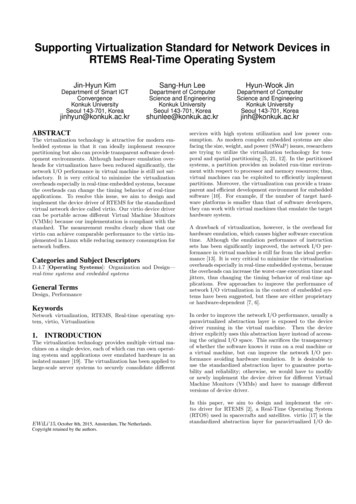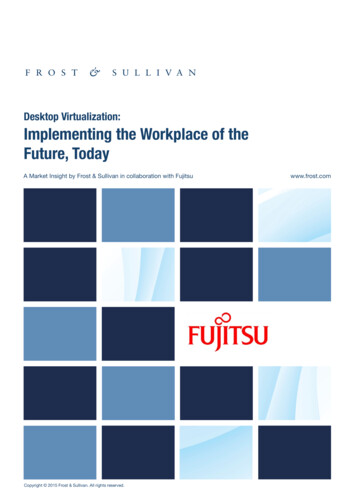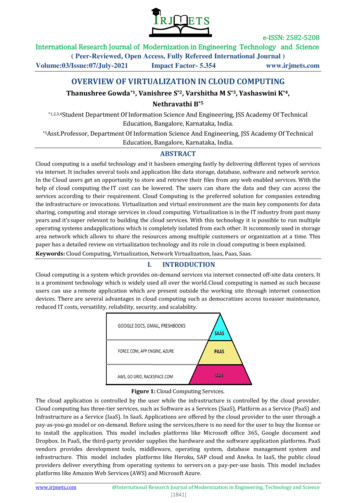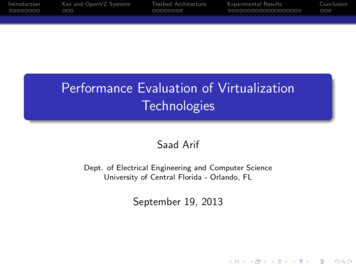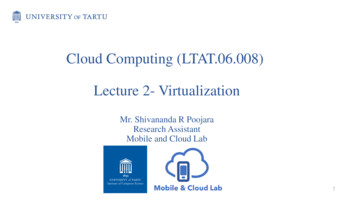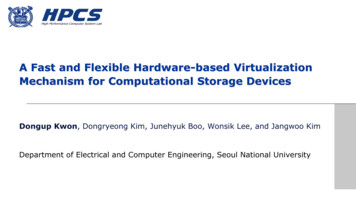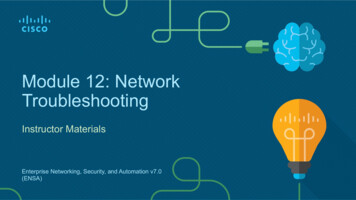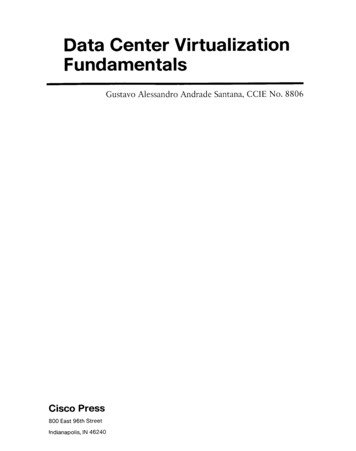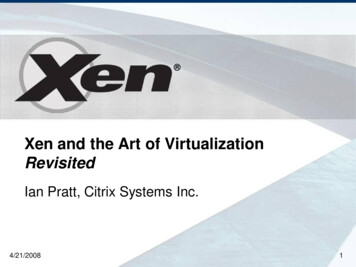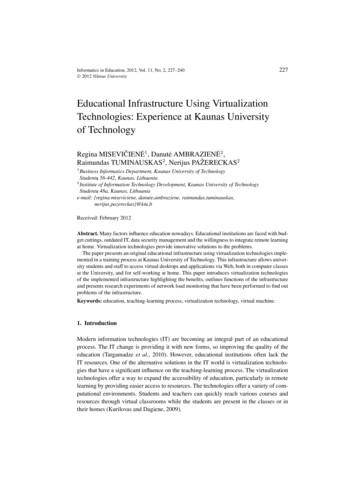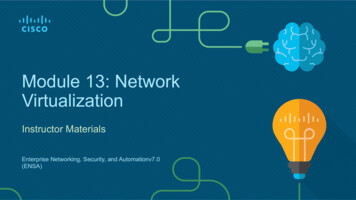
Transcription
Module 13: NetworkVirtualizationInstructor MaterialsEnterprise Networking, Security, and Automationv7.0(ENSA)
Module 13: NetworkVirtualizationEnterprise Networking, Security, and Automation v7.0(ENSA)
Module ObjectivesModule Title: Network VirtualizationModule Objective: Explain the purpose and characteristics of network virtualization.Topic TitleTopic ObjectiveCloud ComputingExplain the importance of cloud computing.VirtualizationExplain the importance of virtualization.Virtual Network InfrastructureDescribe the virtualization of network devices andservices.Software-Defined Networking Describe software-defined networking.ControllersDescribe controllers used in network programming. 2016 Cisco and/or its affiliates. All rights reserved. Cisco Confidential10
13.1 Cloud Computing 2016 Cisco and/or its affiliates. All rights reserved. Cisco Confidential11
Cloud ComputingVideo - Cloud and VirtualizationThis video will cover the following: Data centers Cloud computing (SaaS, PaaS, and IaaS) Virtualization (Type 1 Hypervisor, Type 2 Hypervisor) 2016 Cisco and/or its affiliates. All rights reserved. Cisco Confidential12
Cloud ComputingCloud OverviewCloud computing addresses a variety of data management issues: Enables access to organizational data anywhere and at any time Streamlines the organization’s IT operations by subscribing only to needed services Eliminates or reduces the need for onsite IT equipment, maintenance, andmanagement Reduces cost for equipment, energy, physical plant requirements, and personneltraining needs Enables rapid responses to increasing data volume requirements 2016 Cisco and/or its affiliates. All rights reserved. Cisco Confidential13
Cloud ComputingCloud ServicesThe three main cloud computing services defined by the National Institute of Standardsand Technology (NIST) in their Special Publication 800-145 are as follows: Software as a Service (SaaS) - The cloud provider is responsible for access toapplications and services that are delivered over the internet. Platform as a Service (PaaS) - The cloud provider is responsible for providing usersaccess to the development tools and services used to deliver the applications. Infrastructure as a Service (IaaS) - The cloud provider is responsible for giving ITmanagers access to the network equipment, virtualized network services, andsupporting network infrastructure.Cloud service providers have extended this model to also provide IT support for each ofthe cloud computing services (ITaaS). For businesses, ITaaS can extend the capability ofthe network without requiring investment in new infrastructure, training new personnel, orlicensing new software. 2016 Cisco and/or its affiliates. All rights reserved. Cisco Confidential14
Cloud ComputingCloud ModelsThere are four primary cloud models: Public clouds - Cloud-based applications and services made available to the generalpopulation. Private clouds - Cloud-based applications and services intended for a specificorganization or entity, such as the government. Hybrid clouds - A hybrid cloud is made up of two or more clouds (example: partprivate, part public), where each part remains a separate object, but both areconnected using a single architecture. Community clouds - A community cloud is created for exclusive use by a specificcommunity. The differences between public clouds and community clouds are thefunctional needs that have been customized for the community. For example,healthcare organizations must remain compliant with policies and laws (e.g., HIPAA)that require special authentication and confidentiality. 2016 Cisco and/or its affiliates. All rights reserved. Cisco Confidential15
Cloud ComputingCloud Computing versus Data CenterThese are the correct definitions of data center and cloud computing: Data center: Typically, a data storage and processing facility run by an in-house ITdepartment or leased offsite. Data centers are typically very expensive to build andmaintain. Cloud computing: Typically, an off-premise service that offers on-demand access toa shared pool of configurable computing resources. These resources can be rapidlyprovisioned and released with minimal management effort.Data centers are the physical facilities that provide the compute, network, and storageneeds of cloud computing services. Cloud service providers use data centers to host theircloud services and cloud-based resources. 2016 Cisco and/or its affiliates. All rights reserved. Cisco Confidential16
13.2 Virtualization 2016 Cisco and/or its affiliates. All rights reserved. Cisco Confidential17
VirtualizationCloud Computing and Virtualization The terms “cloud computing” and“virtualization” are often usedinterchangeably; however, they meandifferent things. Virtualization is thefoundation of cloud computing.Without it, cloud computing, as it ismost-widely implemented, would notbe possible.Virtualization separates the operatingsystem (OS) from the hardware.Various providers offer virtual cloudservices that can dynamicallyprovision servers as required. Thesevirtualized instances of servers arecreated on demand. 2016 Cisco and/or its affiliates. All rights reserved. Cisco Confidential18
VirtualizationDedicated ServersHistorically, enterprise servers consisted of aserver OS, such as Windows Server or LinuxServer, installed on specific hardware. All ofa server’s RAM, processing power, and harddrive space were dedicated to the serviceprovided (e.g., Web, email services, etc.). When a component fails, the service that isprovided by this server becomes unavailable.This is known as a single point of failure.Dedicated servers were generally underused.They often sat idle for long periods of time,waiting until there was a need to deliver thespecific service they provide. These serverswasted energy and took up more space thanwas warranted by the amount of serviceprovided. This is known as server sprawl. 2016 Cisco and/or its affiliates. All rights reserved. Cisco Confidential19
VirtualizationServer Virtualization Server virtualization takes advantage of idleresources and consolidates the number ofrequired servers. This also allows formultiple operating systems to exist on asingle hardware platform.The use of virtualization normally includesredundancy to protect from a single point offailure.The hypervisor is a program, firmware, orhardware that adds an abstraction layer ontop of the physical hardware. Theabstraction layer is used to create virtualmachines which have access to all thehardware of the physical machine such asCPUs, memory, disk controllers, and NICs. 2016 Cisco and/or its affiliates. All rights reserved. Cisco Confidential20
VirtualizationAdvantages of VirtualizationOne major advantage of virtualization is overall reduced cost: Less equipment is required Less energy is consumed Less space is requiredThese are additional benefits of virtualization: Easier prototyping Faster server provisioning Increased server uptime Improved disaster recovery Legacy support 2016 Cisco and/or its affiliates. All rights reserved. Cisco Confidential21
VirtualizationAbstraction LayersA computer system consists of the following abstraction layers: Services, OS, Firmware,and Hardware. At each of these layers of abstraction, some type of programming code is used as aninterface between the layer below and the layer above. A hypervisor is installed between the firmware and the OS. The hypervisor cansupport multiple instances of OSs. 2016 Cisco and/or its affiliates. All rights reserved. Cisco Confidential22
VirtualizationType 2 Hypervisors A Type 2 hypervisor is software that creates and runs VM instances. The computer, onwhich a hypervisor is supporting one or more VMs, is a host machine. Type 2hypervisors are also called hosted hypervisors.A big advantage of Type 2 hypervisors is that management console software is notrequired. 2016 Cisco and/or its affiliates. All rights reserved. Cisco Confidential23
13.3 Virtual NetworkInfrastructure 2016 Cisco and/or its affiliates. All rights reserved. Cisco Confidential24
Virtual Network InfrastructureType 1 Hypervisors Type 1 hypervisors are also called the “bare metal” approach because the hypervisoris installed directly on the hardware. Type 1 hypervisors are usually used onenterprise servers and data center networking devices.With Type 1 hypervisors, the hypervisor is installed directly on the server ornetworking hardware. Then, instances of an OS are installed on the hypervisor, asshown in the figure. Type 1 hypervisors have direct access to the hardware resources.Therefore, they are more efficient than hosted architectures. Type 1 hypervisorsimprove scalability, performance, and robustness. 2016 Cisco and/or its affiliates. All rights reserved. Cisco Confidential25
Virtual Network InfrastructureInstalling a VM on a Hypervisor Type 1 hypervisors require a “management console” to manage the hypervisor.Management software is used to manage multiple servers using the same hypervisor.The management console can automatically consolidate servers and power on or offservers as required.The management console provides recovery from hardware failure. If a servercomponent fails, the management console automatically moves the VM to anotherserver. Cisco Unified Computing System (UCS) Manager controls multiple serversand manages resources for thousands of VMs.Some management consoles also allow server over allocation. Over allocation iswhen multiple OS instances are installed, but their memory allocation exceeds thetotal amount of memory that a server has. Over allocation is a common practicebecause all four OS instances rarely require the all their allocated resources at anyone moment. 2016 Cisco and/or its affiliates. All rights reserved. Cisco Confidential26
Virtual Network InfrastructureThe Complexity of Network Virtualization Server virtualization hides server resources. Thiscan create problems when using traditionalnetwork architectures.VMs are movable, and the network administratormust be able to add, drop, and change networkresources and profiles to support their mobility.This process would be manual and timeconsuming with traditional network switches.Traffic flows differ from the traditional clientserver model. Typically, there is a considerableamount of traffic being exchanged betweenvirtual servers (East-West traffic) that changes inlocation and intensity over time. North-Southtraffic is typically traffic destined for offsitelocations such as another data center, othercloud providers, or the internet. 2016 Cisco and/or its affiliates. All rights reserved. Cisco Confidential27
Virtual Network InfrastructureThe Complexity of Network Virtualization (Cont.) Dynamic ever-changing traffic requires a flexible approach to network resourcemanagement. Existing network infrastructures can respond to changing requirementsrelated to the management of traffic flows by using Quality of Service (QoS) andsecurity level configurations for individual flows. However, in large enterprises usingmultivendor equipment, each time a new VM is enabled, the necessaryreconfiguration can be very time-consuming.The network infrastructure can also benefit from virtualization. Network functions canbe virtualized. Each network device can be segmented into multiple virtual devicesthat operate as independent devices. Examples include subinterfaces, virtualinterfaces, VLANs, and routing tables. Virtualized routing is called virtual routing andforwarding (VRF). 2016 Cisco and/or its affiliates. All rights reserved. Cisco Confidential28
13.4 Software-DefinedNetworking 2016 Cisco and/or its affiliates. All rights reserved. Cisco Confidential29
Software-Defined NetworkingVideo - Software-Defined NetworkingThis video will cover the following: Network Programming SDN (Open Network Foundation, OpenFlow, and OpenStack) Controllers 2016 Cisco and/or its affiliates. All rights reserved. Cisco Confidential30
Software-Defined NetworkingControl Plane and Data PlaneA network device contains the following planes: Control plane - This is typically regarded as the brains of a device. It is used to makeforwarding decisions. The control plane contains Layer 2 and Layer 3 route forwardingmechanisms, such as routing protocol neighbor tables and topology tables, IPv4 andIPv6 routing tables, STP, and the ARP table. Information sent to the control plane isprocessed by the CPU. Data plane - Also called the forwarding plane, this plane is typically the switch fabricconnecting the various network ports on a device. The data plane of each device isused to forward traffic flows. Routers and switches use information from the controlplane to forward incoming traffic out the appropriate egress interface. Information inthe data plane is typically processed by a special data plane processor without theCPU getting involved. 2016 Cisco and/or its affiliates. All rights reserved. Cisco Confidential31
Software-Defined NetworkingControl Plane and Data Plane (Cont.) CEF is an advanced, Layer 3 IP switchingtechnology that enables forwarding ofpackets to occur at the data plane withoutconsulting the control plane.SDN is basically the separation of thecontrol plane and data plane. The controlplane function is removed from eachdevice and is performed by a centralizedcontroller. The centralized controllercommunicates control plane functions toeach device. Each device can now focuson forwarding data while the centralizedcontroller manages data flow, increasessecurity, and provides other services. 2016 Cisco and/or its affiliates. All rights reserved. Cisco Confidential32
Software-Defined NetworkingControl Plane and Data Plane (Cont.) The management plane is responsible for managing a device through its connectionto the network.Network administrators use applications such as Secure Shell (SSH), Trivial FileTransfer Protocol (TFTP), Secure FTP, and Secure Hypertext Transfer Protocol(HTTPS) to access the management plane and configure a device.The management plane is how you have accessed and configured devices in yournetworking studies. In addition, protocols like Simple Network Management Protocol(SNMP), use the management plane. 2016 Cisco and/or its affiliates. All rights reserved. Cisco Confidential33
Software-Defined NetworkingNetwork Virtualization TechnologiesTwo major network architectures have been developed to support network virtualization: Software-Defined Networking (SDN) - A network architecture that virtualizes thenetwork, offering a new approach to network administration and management thatseeks to simplify and streamline the administration process. Cisco Application Centric Infrastructure (ACI) - A purpose-built hardware solutionfor integrating cloud computing and data center management. 2016 Cisco and/or its affiliates. All rights reserved. Cisco Confidential34
Software-Defined NetworkingNetwork Virtualization Technologies (Cont.)Components of SDN may include the following: OpenFlow - This approach was developed at Stanford University to manage trafficbetween routers, switches, wireless access points, and a controller. The OpenFlowprotocol is a basic element in building SDN solutions. OpenStack - This approach is a virtualization and orchestration platform designed tobuild scalable cloud environments and provide an IaaS solution. OpenStack is oftenused with Cisco ACI. Orchestration in networking is the process of automating theprovisioning of network components such as servers, storage, switches, routers, andapplications. Other components - Other components include Interface to the Routing System(I2RS), Transparent Interconnection of Lots of Links (TRILL), Cisco FabricPath (FP),and IEEE 802.1aq Shortest Path Bridging (SPB). 2016 Cisco and/or its affiliates. All rights reserved. Cisco Confidential35
Software-Defined NetworkingTraditional and SDN ArchitecturesIn a traditional router or switch architecture, the control plane and data plane functionsoccur in the same device. Routing decisions and packet forwarding are the responsibilityof the device operating system. In SDN, management of the control plane is moved to acentralized SDN controller. The figure compares traditional and SDN architectures. 2016 Cisco and/or its affiliates. All rights reserved. Cisco Confidential36
Software-Defined NetworkingTraditional and SDN Architectures (Cont.) The SDN controller is a logical entity that enablesnetwork administrators to manage and dictate how thedata plane of switches and routers should handlenetwork traffic. It orchestrates, mediates, and facilitatescommunication between applications and networkelements.The complete SDN framework is shown in the figure.Note the use of Application Programming Interfaces(APIs). An API is a standardized definition of the properway for an application to request services from anotherapplication.The SDN controller uses northbound APIs tocommunicate with the upstream applications, helpingnetwork administrators shape traffic and deploy services.The SDN controller uses southbound APIs to define thebehavior of the data planes on downstream switchesand routers. OpenFlow is a widely implementedsouthbound API. 2016 Cisco and/or its affiliates. All rights reserved. Cisco Confidential37
13.5 Controllers 2016 Cisco and/or its affiliates. All rights reserved. Cisco Confidential38
ControllersSDN Controller and Operations The SDN controller defines thedata flows between thecentralized control plane and thedata planes on individual routersand switches.Each flow traveling through thenetwork must first get permissionfrom the SDN controller, whichverifies that the communication ispermissible according to thenetwork policy.All complex functions areperformed by the controller. Thecontroller populates flow tables.Switches manage the flow tables. 2016 Cisco and/or its affiliates. All rights reserved. Cisco Confidential39
ControllersSDN Controller and Operations (Cont.)Within each switch, a series of tables implemented in hardware or firmware are used tomanage the flows of packets through the switch. To the switch, a flow is a sequence ofpackets that matches a specific entry in a flow table.The three table types shown in the previous figure are as follows: Flow Table - This table matches incoming packets to a particular flow and specifies the functionsthat are to be performed on the packets. There may be multiple flow tables that operate in apipeline fashion. Group Table - A flow table may direct a flow to a Group Table, which may trigger a variety ofactions that affect one or more flows. Meter Table - This table triggers a variety of performance-related actions on a flow including theability to rate-limit the traffic. 2016 Cisco and/or its affiliates. All rights reserved. Cisco Confidential40
ControllersVideo - Cisco ACI Very few organizations actually have the desire or skill to program the network usingSDN tools. However, the majority of organizations want to automate the network,accelerate application deployments, and align their IT infrastructures to better meetbusiness requirements. Cisco developed the Application Centric Infrastructure (ACI) tomeet these objectives in more advanced and innovative ways than earlier SDNapproaches.Cisco ACI is a hardware solution for integrating cloud computing and data centermanagement. At a high level, the policy element of the network is removed from thedata plane. This simplifies the way data center networks are created. 2016 Cisco and/or its affiliates. All rights reserved. Cisco Confidential41
ControllersCore Components of ACIThere are three core components of the ACI architecture: Application Network Profile (ANP) - An ANP is a collection of end-point groups (EPG), theirconnections, and the policies that define those connections. Application Policy Infrastructure Controller (APIC) - APIC is a centralized software controllerthat manages and operates a scalable ACI clustered fabric. It is designed for programmability andcentralized management. It translates application policies into network programming. Cisco Nexus 9000 Series switches - These switches provide an application-aware switchingfabric and work with an APIC to manage the virtual and physical network infrastructure.The APIC is positioned between the APN and the ACI-enabled network infrastructure. TheAPIC translates the application requirements into a network configuration to meet thoseneeds. 2016 Cisco and/or its affiliates. All rights reserved. Cisco Confidential42
ControllersCore Components of ACI (Cont.) 2016 Cisco and/or its affiliates. All rights reserved. Cisco Confidential43
ControllersSpine-Leaf Topology The Cisco ACI fabric is composed of theAPIC and the Cisco Nexus 9000 seriesswitches using two-tier spine-leaftopology, as shown in the figure. The leafswitches attach to the spines, but theynever attach to each other. Similarly, thespine switches only attach to the leaf andcore switches (not shown). In this twotier topology, everything is one hop fromeverything else.When compared to SDN, the APICcontroller does not manipulate the datapath directly. Instead, the APICcentralizes the policy definition andprograms the leaf switches to forwardtraffic based on the defined policies. 2016 Cisco and/or its affiliates. All rights reserved. Cisco Confidential44
ControllersSDN TypesThe Cisco Application Policy Infrastructure Controller - Enterprise Module (APIC-EM)extends ACI aimed at enterprise and campus deployments. To better understand APICEM, it is helpful to take a broader look at the three types of SDN: Device-based SDN: Devices are programmable by applications running on the deviceitself or on a server in the network, as shown in the figure. 2016 Cisco and/or its affiliates. All rights reserved. Cisco Confidential45
ControllersSDN Types (Cont.)Controller-based SDN: Uses a centralized controller that has knowledge of all devices inthe network, as shown in the figure. The applications can interface with the controllerresponsible for managing devices and manipulating traffic flows throughout the network.The Cisco Open SDN Controller is a commercial distribution of OpenDaylight. 2016 Cisco and/or its affiliates. All rights reserved. Cisco Confidential46
ControllersSDN Types (Cont.)Policy-based SDN: Similar to controllerbased SDN where a centralized controllerhas a view of all devices in the network,as shown in the figure. Policy-based SDNincludes an additional Policy layer thatoperates at a higher level of abstraction.It uses built-in applications that automateadvanced configuration tasks via aguided workflow and user-friendly GUI.No programming skills are required.Cisco APIC-EM is an example of this typeof SDN. 2016 Cisco and/or its affiliates. All rights reserved. Cisco Confidential47
ControllersAPIC-EM FeaturesCisco APIC-EM provides a singleinterface for network managementincluding: Discovering and accessing deviceand host inventories. Viewing the topology (as shown inthe figure). Tracing a path between end points. Setting policies. 2016 Cisco and/or its affiliates. All rights reserved. Cisco Confidential48
ControllersAPIC-EM Path TraceThe APIC-EM Path Trace tool allowsthe administrator to easily visualizetraffic flows and discover anyconflicting, duplicate, or shadowedACL entries. This tool examinesspecific ACLs on the path betweentwo end nodes, displaying anypotential issues. You can see whereany ACLs along the path eitherpermitted or denied your traffic, asshown in the figure. Notice howBranch-Router2 is permit all traffic.The network administrator can nowmake adjustments, if necessary, tobetter filter traffic. 2016 Cisco and/or its affiliates. All rights reserved. Cisco Confidential49
13.6 Module Practice and Quiz 2016 Cisco and/or its affiliates. All rights reserved. Cisco Confidential50
Module Practice and QuizLab - Install Linux in a Virtual Machine and Explore the GUIIn this lab, you will install will complete the following objective; Prepare a Computer for Virtualization Install a Linux OS on the Virtual Machine Explore the GUI 2016 Cisco and/or its affiliates. All rights reserved. Cisco Confidential51
Module Practice and QuizWhat Did I Learn In This Module? Cloud computing involves large numbers of computers connected through a network that can be physically located anywhere. Cloud computing can reduce operational costs by using resources more efficiently.The three main cloud computing services defined by the National Institute of Standards and Technology(NIST) are Software as a Service (SaaS), Platform as a Service (PaaS), and Infrastructure as a Service(IaaS).The four types of clouds are public, private, hybrid, and community.Virtualization is the foundation of cloud computing. Virtualization separates the operating system (OS) fromthe hardware.Virtualization reduces costs because less equipment is required, less energy is consumed, and less spaceis required. It provides for easier prototyping, faster server provisioning, increased server uptime, improveddisaster recovery, and legacy support.With Type 1 hypervisors, the hypervisor is installed directly on the server or networking hardware. A Type 2hypervisor is software that creates and runs VM instances. It can be installed on top of the OS or can beinstalled between the firmware and the OS. 2016 Cisco and/or its affiliates. All rights reserved. Cisco Confidential52
Module Practice and QuizWhat Did I Learn In This Module? (Cont.) Type 1 hypervisors are also called the “bare metal” approach because the hypervisor is installed directly on the hardware. Type 1 hypervisors have direct access to the hardware resources and are more efficient thanhosted architectures. They improve scalability, performance, and robustness.Type 1 hypervisors require a “management console” to manage the hypervisor.Server virtualization hides server resources, such as the number and identity of physical servers,processors, and OSs from server users. This practice can create problems if the data center is usingtraditional network architectures.Traffic flows in the data center differ substantially from the traditional client-server model. Typically, a datacenter has a considerable amount of traffic being exchanged between virtual servers (East-West traffic)and can change in location and intensity over time. North-South traffic occurs between the distribution andcore layers and is typically traffic destined for offsite locations such as another data center, other cloudproviders, or the internet.Two major network architectures have been developed to support network virtualization: Software-DefinedNetworking (SDN) and Cisco Application Centric Infrastructure (ACI).Components of SDN may include OpenFlow, OpenStack, and other components. 2016 Cisco and/or its affiliates. All rights reserved. Cisco Confidential53
Module Practice and QuizWhat Did I Learn In This Module? (Cont.) A network device contains a control plane and a data plane. The control plane is regarded as the brains of a device.SDN is basically the separation of the control plane and data plane. The control plane function is removedfrom each device and is performed by a centralized controllerThe SDN controller is a logical entity that enables network administrators to manage and dictate how thedata plane of switches and routers should handle network traffic.The data plane, also called the forwarding plane, is typically the switch fabric connecting the variousnetwork ports on a device, and is used to forward traffic flows.The management plane is responsible for managing a device through its connection to the network.The SDN controller is a logical entity that enables network administrators to manage and dictate how thedata plane of switches and routers should handle network traffic.Cisco developed the Application Centric Infrastructure (ACI) which is more advanced and innovative thanearlier SDN approaches.Cisco ACI is a hardware solution for integrating cloud computing and data center management.At a high level, the policy element of the network is removed from the data plane. This simplifies the waydata center networks are created. 2016 Cisco and/or its affiliates. All rights reserved. Cisco Confidential54
Module Practice and QuizWhat Did I Learn In This Module? (Cont.) The three core components of the ACI architecture are Application Network Profile (ANP), Application Policy Infrastructure Controller (APIC), and Cisco Nexus 9000 Series switches.The Cisco ACI fabric is composed of the APIC and the Cisco Nexus 9000 series switches using two-tierspine-leaf topology.When compared to SDN, the APIC controller does not manipulate the data path directly. Instead, the APICcentralizes the policy definition and programs the leaf switches to forward traffic based on the definedpolicies.There are three types of SDN: Device-based SDN, Controller-based SDN, and Policy-based SDN.Policy-based SDN includes an additional Policy layer that operates at a higher level of abstraction. Policybased SDN is the most robust, providing for a simple mechanism to control and manage policies acrossthe entire network.Cisco APIC-EM is an example of policy-based SDN. Cisco APIC-EM provides a single interface for networkmanagement including discovering and accessing device and host inventories, viewing the topology,tracing a path between end points, and setting policies.The APIC-EM Path Trace tool allows the administrator to easily visualize traffic flows and discover anyconflicting, duplicate, or shadowed ACL entries. This tool examines specific ACLs on the path between twoend nodes, displaying any potential issues. 2016 Cisco and/or its affiliates. All rights reserved. Cisco Confidential55
The Complexity of Network Virtualization (Cont.) Dynamic ever-changing traffic requires a flexible approach to network resource management. Existing network infrastructures can respond to changing requirements related to the management of traffic flows by using Quality of Service (QoS) and security level configurations for individual flows.
